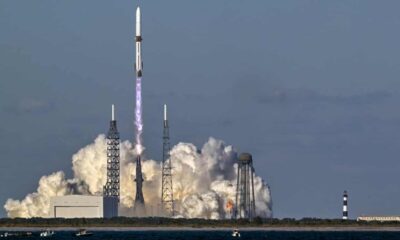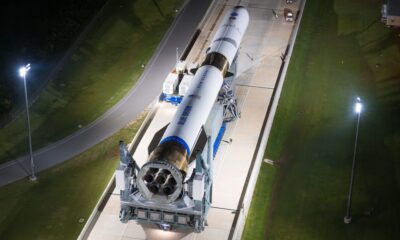Science
Blue Origin’s New Glenn Rocket Achieves Historic Atlantic Landing

Blue Origin’s New Glenn rocket made headlines on Thursday with a successful landing on a floating platform in the Atlantic Ocean, marking a significant milestone for the company. The 18-story-tall rocket launched from the Cape Canaveral Space Force Station in Florida at 15:55 EST (20:55 UTC) and achieved a precise touchdown nine minutes later, following a brief journey into space.
The launch had faced delays due to poor weather conditions and a solar storm that posed hazards to Earth earlier in the week. Following the successful mission, Dave Limp, CEO of Blue Origin, expressed pride in his team, stating, “We achieved full mission success today. It turns out Never Tell Me The Odds had perfect odds—never before in history has a booster this large nailed the landing on the second try.”
The New Glenn rocket set sail carrying two NASA science probes, embarking on a two-year mission to Mars. This launch marked the first time operational satellites flew aboard Blue Origin’s new rocket, named after the late NASA astronaut John Glenn. As the rocket ascended, it fired its seven BE-4 main engines for nearly three minutes, generating over 3.8 million pounds of thrust using super-cold liquefied natural gas and liquid oxygen.
Following the initial phase of the flight, the first stage booster reached an altitude of 79 miles (127 kilometers) before executing a controlled descent back to Earth. The rocket reignited three of its engines to slow its descent and, just before landing, extended its landing gear to settle on the recovery platform named Jacklyn, positioned 375 miles (600 kilometers) from Cape Canaveral.
Significance of the Landing
This momentous landing was celebrated across Blue Origin facilities, with employees watching live feeds of the event. The New Glenn rocket’s successful recovery marks an important achievement, as it is the first time a company other than SpaceX has propulsively landed an orbital-class rocket booster. This accomplishment comes nearly a decade after SpaceX’s historic recovery of its Falcon 9 booster in December 2015.
The New Glenn rocket had previously launched successfully in January, but technical issues prevented its booster from restarting engines during descent, leading to a crash at sea. Engineers implemented improvements in propellant management and engine bleed control, leading to Thursday’s success.
With only one recovery accomplished, Blue Origin now stands at the second position in the rankings for propulsive landings of orbital-class boosters, while SpaceX has achieved 532 landings with its fleet. Blue Origin is also known for its 34 landings of the suborbital New Shepard model, which, while successful, does not match the capabilities of the New Glenn.
Future Missions and Research Goals
Looking ahead, Blue Origin plans to reuse the New Glenn booster for the launch of the Blue Moon Mark 1 lunar cargo lander next year. The company envisions a fleet of reusable boosters capable of being flown up to 25 times, similar to SpaceX’s Falcon 9. The New Glenn rocket plays a crucial role in Blue Origin’s strategy for NASA’s Artemis lunar program, which aims to send astronauts to the Moon.
In addition to commercial aspirations, the launch’s secondary mission involved deploying NASA’s two ESCAPADE satellites. These satellites are set to study the interaction between solar wind and the Martian atmosphere over the course of nearly two years. Following successful deployments, Rob Lillis, principal investigator for ESCAPADE, expressed relief and excitement about the mission’s potential to enhance understanding of Mars’ environment.
The ESCAPADE project, developed on a budget of approximately $80 million, was managed by the University of California, Berkeley, with Blue Origin receiving around $20 million for the launch. Despite the challenges faced during preparations, the successful mission is a step toward deeper exploration of Mars and understanding its climate history.
NASA’s Nicky Fox emphasized the importance of studying Martian space weather, stating, “Understanding Martian space weather is a top priority for future missions because it helps us protect systems, robots, and most importantly, humans, in extreme environments.”
As Blue Origin continues to forge its path in the aerospace industry, the successful mission of the New Glenn rocket stands as a testament to the company’s growing capabilities and ambitions.
-

 Politics1 week ago
Politics1 week agoSecwepemc First Nation Seeks Aboriginal Title Over Kamloops Area
-

 World4 months ago
World4 months agoScientists Unearth Ancient Antarctic Ice to Unlock Climate Secrets
-

 Entertainment4 months ago
Entertainment4 months agoTrump and McCormick to Announce $70 Billion Energy Investments
-

 Lifestyle4 months ago
Lifestyle4 months agoTransLink Launches Food Truck Program to Boost Revenue in Vancouver
-

 Science4 months ago
Science4 months agoFour Astronauts Return to Earth After International Space Station Mission
-

 Technology3 months ago
Technology3 months agoApple Notes Enhances Functionality with Markdown Support in macOS 26
-

 Top Stories1 month ago
Top Stories1 month agoUrgent Update: Fatal Crash on Highway 99 Claims Life of Pitt Meadows Man
-

 Sports4 months ago
Sports4 months agoSearch Underway for Missing Hunter Amid Hokkaido Bear Emergency
-

 Politics3 months ago
Politics3 months agoUkrainian Tennis Star Elina Svitolina Faces Death Threats Online
-

 Politics4 months ago
Politics4 months agoCarney Engages First Nations Leaders at Development Law Summit
-

 Technology4 months ago
Technology4 months agoFrosthaven Launches Early Access on July 31, 2025
-

 Top Stories3 weeks ago
Top Stories3 weeks agoFamily Remembers Beverley Rowbotham 25 Years After Murder





















